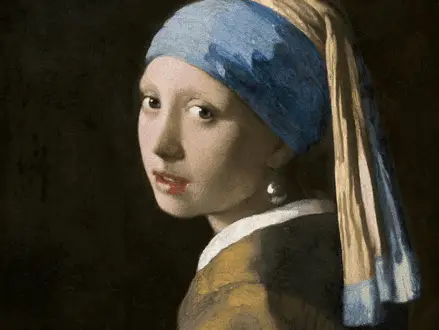Title of Artwork: “Girl with the Pearl Earring”

Artwork by Johannes Vermeer
Year Created 1665
Summary of Girl with the Pearl Earring
The Girl with a Pearl Earring is as iconic to the Dutch as Leonardo da Vinci’s Mona Lisa is to the Italians, and it’s little wonder why. A young woman’s face is partially obscured by a dark backdrop in this photograph. The sparkling eyes and slightly parted lips of someone ready to speak catch the attention of the audience. It’s not obvious whether she’s facing the viewer or not.
All About Girl with the Pearl Earring
Vermeer was posthumously dubbed the “Master of Light” and was well-known for his careful attention to the way light played on skin, textiles, and precious stones, as can be seen in the play of light on the girl’s face, eyes, and lips. Scholars have lauded Vermeer’s use of soft tones to suggest her face’s many aspects and the absence of a clear linear difference between her nose and cheeks. The soft pink and white accents on the lips, meanwhile, give them a wet, squishy appearance, heightening the ethereal feel of the picture. The spectator is left to wonder whether she stopped speaking when she established eye contact with them or if she had just taken a breather.
It’s more likely that Vermeer’s contemporaries would have called this work a “tronie” than a “portrait,” because it depicts a stock character in costume with idealized, exaggerated facial expressions, representing characteristics of exotic or foreign countries that were becoming apparent in Dutch society as a result of the burgeoning trade industry.” This may be seen in the girl’s fanciful turban, which is unlike anything seen in Dutch or even European daily life. Pearls were brought from the Persian Gulf, thus the iridescent globe dangling from her left ear.
The mystery surrounds why Vermeer painted this particular piece, as it does with many of his other creations. While Rembrandt accepted commissions and taught students to make a living, Van Gogh had greater flexibility. As a result, it seems that Vermeer painted the girl as a kind of self-expression and entertainment. One theory is that it was either his eldest daughter Maria or his patron’s own daughter Magdalena van Ruijven. Both girls would have been twelve or thirteen years old when the picture was done. If that’s the case, it indicates a wish to preserve the beauty of his own child or the child of a friend for future generations to admire.
Restored long overdue and made famous by Tracy Chevalier’s 1999 book Girl with a Pearl Earring, this painting was painted in about 1665 but didn’t become a household name until the beginning of the twentieth century.
Contemporary artists continue to be influenced by this work. Banksy, a well-known British street artist, used tonally applied deep blue paint to rework the image on a wall in Bristol. There is now a burglar alarm in place of the famous pearl, on which historians are split on whether it is an exceptionally big pearl or just polished tin.
Regardless of the girl’s identity or the genuineness of her pearl, her face will forever be associated with Baroque art’s golden period of adolescence.
Information Citations
En.wikipedia.org, https://en.wikipedia.org/.
























